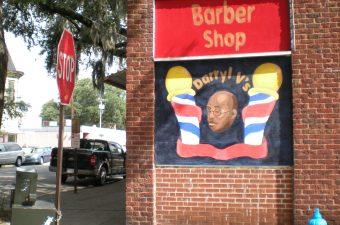
Section Branding
Header Content
Hand-Painted Signs Evoke Nostalgia
Primary Content

Historic Savannah is getting its first-ever McDonald's.
The arrival of the Golden Arches is just the latest corporate sign to make its way into an area known for stately homes and Spanish moss.
The Gap, Banana Republic and Outback all have signs in Savannah's Historic District.
It makes some residents nostalgic for a rarely discussed bit of Savannah history that some are trying to preserve: hand-painted commercial signs.
They're on walls all over: on barber shops, on seafood joints and even on churches.
But mostly, they’re in poor, African-American neighborhoods.
Leonard Miller remembers where he was when he started painting some of Savannah's hand-lettered signs.
It was a pizza shop and his mentor was a well known sign painter -- among a skilled group known as "wall dogs."
"It was the summer of 1984 and he said, 'Young man, you have a lot of talent, but you're using the wrong tools to do the job,'" Miller says. "Of course in those days, I figured if I got a hold of a good oil-based paint brush and an oil-based paint, I was good to go. But after he turned me on to the right tools to use, my job looked more superior."
Miller is known for his bright, vibrant colors and rounded, large letters with fun drawings of crabs or dancing shrimp.
Hand-painted signs like these used to cover the city, but Miller says, today, they’re disappearing.
"A hand-painted sign from my point-of-view is much more of a personal touch," Miller says. "It's a style and a skill that seems to be vanishing in this day and age. And it should be preserved."
Susan Falls is trying to do just that.
"Now right up here was the 'DO! Not Block Gate,'" says Falls, an anthropology professor at the Savannah College of Art and Design, leading a reporter around on a tour of Savannah's hand-painted signs.
Among the signs she has preserved in hundreds of photos, one admonishes drivers not to park in a driveway.
"And it said, 'DO! Not Block Gate.' So, I ran over the very next day and took a picture of it and I came back the day after that they had painted the entire thing black again."
Many of the signs don't last long.
They disappear when businesses or neighbors change.
Falls sees gentrification of poor areas as bad news for hand-painted signs.
And when the signs disappear, so does a unique part of the landscape.
Since Savannah’s wall dogs are so few in number, they've given this city its very own themes, colors and even fonts.
"So for example, like this signage over here, for the Savannah Barber Shop, the letters are much more Gothic with sharper angles and more fanciful endings," Falls says. "And actually this font that we see right here is something that you can see all around Savannah."
The signs with the fanciful font have been attributed to the late William Pleasant.
Falls says, to some, the signs represent poverty, not being able to afford a "real" sign.
But to her and others, they represent community, one that can’t be replaced by slick corporate signs.
"It creates a sense of place that is sometimes loss when we have a proliferation of corporate signage that really is a sort of signifier of an anywhere or a nowhere rather than a somewhere, like Savannah," Falls says.
A handful of people have started to appreciate Savannah’s hand-painted signs.
But mainly, they brighten corners of Savannah that tourists and many locals never see.
Their admirers say, be on the look out for the signs, since as Savannah grows in corporate America’s eyes, so do the chances that a part the city’s uniqueness will be lost.
Click above for a slideshow of hand-painted signs.
Click below for an interview with Leonard Miller.
Contributors: Victoria Phetmisy contributed writing and reporting.
Tags: Savannah, Savannah College of Art and Design, history, design, African-Americans, GPB News, art, Susan Falls, Leonard Miller, hand-painted signs
